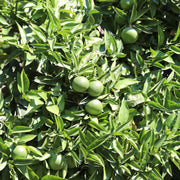Bergamot essential oil (Citrus bergamia) is relaxing and optimistic, but be sure to use bergamot essential oil safely to avoid negative skin reactions.

Bergamot essential oil is cold pressed from the peels of bergamot fruit (sometimes called bergamot orange)—citruses that resemble oranges with bumpy rinds. Their peels can be green, yellow, or orange. Bergamots are too sour to eat, so they’re not as popular as citrus fruits like oranges and lemons. (Although bergamots are sometimes used as flavorings, such as in Earl Grey tea).
Bergamot essential oil has a sweet, citrusy, green-herbal scent . . . and a host of therapeutic uses! However, it’s highly phototoxic.
In this post, you’ll learn what sets bergamot apart from other citruses, how to use bergamot essential oil safely (despite its phototoxic properties), and specific recipes to help you get started blending.

Did you know?
A phototoxic essential oil causes negative skin reactions in sunlight. If you apply a phototoxic oil to skin (at a certain concentration) and then expose that skin to direct sunlight, you can experience burns, blisters, or other skin irritation and skin inflammation.
Bergamot essential oil: a unique citrus
Bergamot essential oil has a lot in common with other citrus oils . . . and also with lavender essential oil! Along with that great bergamot smell, there are a range of other physical and mental health benefits.
Bergamot essential oil's main component is d-limonene, which is present in all citrus oils. d-Limonene has been shown in research to calm nervous, anxious feelings, and to help banish sadness with its relaxing properties. It’s an important component if you’re looking for positive feelings and a calming effect! Bergamot essential oil also contains high percentages of linalool and linalyl acetate, which happen to be the two main components found in lavender oil, so they share many benefits and therapeutic effects.
These two little molecules are largely responsible for lavender’s world-wide reputation for peace and relaxation. They’ve been shown to calm the mind and body as one through their interaction with parasympathetic nervous system activity. They both have this effect individually, and when they appear side by side, they work in synergy to enhance one another’s effects. Their presence in bergamot essential oil makes it helpful for releasing physical and mental tension.
The natural combination of d-limonene, linalool, and linalyl acetate makes bergamot oil a powerhouse for stress relief and easy-going optimism!
Use bergamot essential oil safely: phototoxic concerns

Bergamot essential oil also contains components that are phototoxic.
These components cause negative (and sometimes painful) skin reactions in the sun. You can learn about this issue in more depth on our blog post, “Essential oils & sun exposure: what you need to know.” Here’s a quote from that piece: “Phototoxic essential oils contain natural compounds that react with UV rays. When a phototoxic essential oil is applied to your skin (even if it’s diluted), and that skin is then exposed to sunlight, it can cause burning, blistering, and permanent (or semi-permanent) discoloration.”
Bergamot essential oil is one of the most highly phototoxic essential oils.
Some of the safest ways to use it are through essential oil inhalation (such as essential oil diffuser blends and personal inhalers), and for green cleaning. Try these recipes:
Tips for using bergamot essential oil
To make the most of bergamot essential oil benefits safely in products for topical use, we suggest diluting it at no more than 0.4%. That’s just about 2 drops per 1 oz/30 ml of carrier, like in the essential oil recipes below. If you want to be extra safe, only apply your topical blends to skin that WILL NOT be exposed to the sun, such as in overnight treatment or body wash.
More recipes with bergamot:
If you get bergamot oil on your skin...
If you get even a few drops of undiluted bergamot oil (or other essential oils that are phototoxic, such as lemon essential oil or cold pressed lime essential oil) on your skin, first wash the area with soap and water. Then apply a plain carrier oil, like jojoba oil or avocado oil, to the area.
Use the same precaution if you accidentally apply an essential oil blend that contains more than 0.4% of bergamot. For example, if applied topically in a hand lotion from a 1 oz/28 g bottle that contains 5 drops of bergamot essential oil, go ahead and wash the lotion off your hands, then moisturize with a carrier oil.
Find safe drop counts for other phototoxic oils on our post about sun safety.








